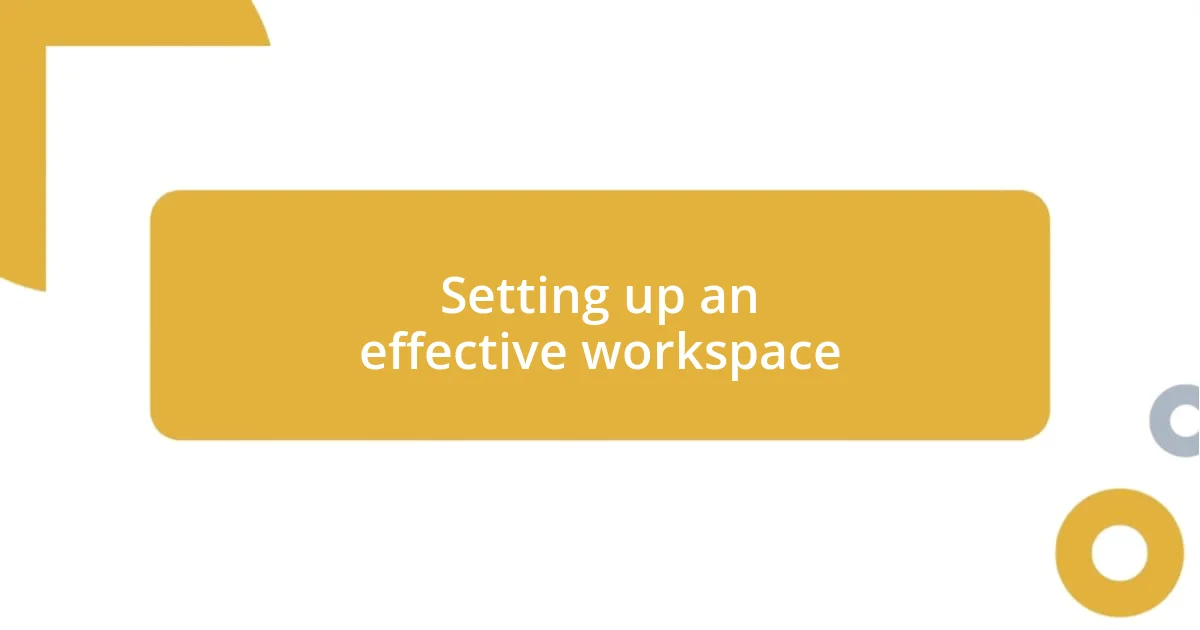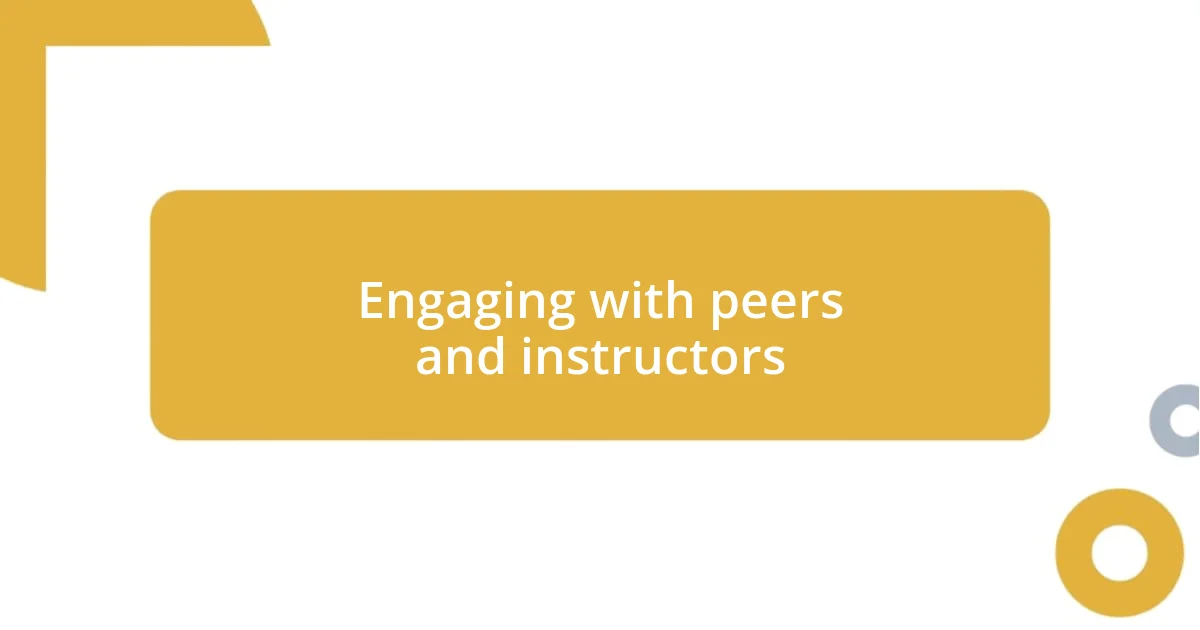Key takeaways:
- Remote learning offers flexibility and a wealth of resources, fostering independence and adaptability in the learning process.
- Establishing a structured workspace and routine enhances productivity, emphasizing the importance of ergonomics, natural light, and scheduled breaks.
- Engaging with peers and instructors through technology tools promotes collaboration and connection, enriching the overall educational experience.

Understanding remote learning benefits
One of the standout benefits of remote learning for me has been the flexibility it offers. Imagine waking up without the stress of a morning commute—what a relief! I’ve found that being able to create my own schedule not only reduces anxiety but also allows me to tailor my learning environment to what suits me best.
I’ve also discovered that remote learning fosters a greater sense of independence. There’s something incredibly empowering about taking charge of my own education. Sure, I miss the in-person interactions sometimes, but I’ve learned to seek out online connections that provide the same sense of community. Have you ever formed a study group over video calls? It’s a unique bonding experience that can lead to genuine friendships, even from a distance.
Finally, I can’t overlook the plethora of resources available at my fingertips. With just a few clicks, I can access an array of courses, webinars, and tutorials that I might never have encountered in a traditional setting. This wealth of information has broadened my horizons and encouraged me to dive into subjects I might have otherwise overlooked. How amazing is it that I can learn about anything, anytime, from the comfort of my home?

Setting up an effective workspace
Setting up an effective workspace is crucial for maximizing productivity in a remote learning environment. In my experience, having a designated area to study makes a world of difference. When I choose a spot that’s comfortable and free from distractions, it creates a boundary that signals my brain that it’s time to focus. I used to work from my bed, and I quickly learned that while it felt cozy, my productivity plummeted.
I’ve found that lighting plays a significant role in how I feel while studying. Natural light boosts my mood and keeps me alert, whereas dimly lit spaces make me feel sluggish. I’ve also incorporated plants in my workspace. The greenery not only enhances the aesthetics but brings a sense of calmness, reminding me of nature. Have you ever noticed how a few plants can change the energy of a room? It’s surprising how an inviting environment can enhance my overall learning experience.
Ergonomics also matter—trust me, your back will thank you later. Investing in a good chair and desk has been a game-changer for me. When I was using a makeshift setup, I often found myself uncomfortable, which distracted me from studying. Now, with the right furniture, I feel empowered to dive into my work without physical discomfort. It’s all about creating an environment that encourages focus, facilitates learning, and nurtures well-being.
| Aspect | Personal Experience |
|---|---|
| Designated Study Area | Improved focus when working in a specific location. |
| Natural Light | Boosts mood and alertness compared to dim lighting. |
| Ergonomics | Investing in good furniture enhanced comfort and concentration. |

Establishing a learning routine
Establishing a learning routine has been my lifeline during remote learning. I found that creating a consistent daily schedule helps me to stay on track and reduces the feeling of overwhelm. Mornings are my dedicated study time where I tackle the most challenging subjects. It’s funny how just a simple choice, like deciding to study at sunrise, can set a productive tone for the rest of the day.
To make my routine feel less rigid and more enjoyable, I incorporate breaks that refresh my mind. Having these mini-breaks isn’t just a luxury; it’s a necessity. They allow me to reset and approach my studies with renewed energy.
Here are a few strategies that work wonders for me while establishing my learning routine:
- Set Specific Study Blocks: Divide your day into chunks dedicated to different subjects, helping to maintain focus.
- Include Breaks: Schedule 5-10 minute breaks every hour. These can help prevent burnout and keep motivation high.
- Use a Planner: I jot down daily tasks and goals—there’s something satisfying about checking things off as I complete them.
- Stick to Consistent Hours: I try to start and end my study days at the same times each day to create a sense of normalcy.
- Incorporate Activities You Love: Whether it’s reading a chapter from a novel or stretching, intersperse activities that make you happy—this keeps my spirits up.
By sharing these practices, I hope to inspire others to find their own unique rhythm with remote learning. Establishing a routine doesn’t have to feel like a chore; it can be an evolving practice that enhances your learning experience tremendously.

Utilizing technology tools effectively
Utilizing technology tools effectively has transformed my remote learning experience. For instance, I rely heavily on note-taking applications like Notion and OneNote, which allow me to keep all my materials organized in one place. It’s almost like having a digital filing cabinet at my fingertips! Each time I share a note with a classmate or revisit my old notes, it feels satisfying to see my learning journey mapped out neatly.
I’ve also discovered the power of video conferencing tools like Zoom and Microsoft Teams. Initially, I felt awkward speaking in front of a camera, but over time, I started embracing it. Isn’t it interesting how the virtual classroom can feel just as engaging as being there in person? Participating in group discussions through these platforms has not only deepened my understanding but also fostered connections with my peers that I didn’t expect to make in a remote setting.
Additionally, I’ve found that leveraging online collaboration tools, such as Google Docs, makes group projects far more manageable. Being able to edit and comment on documents in real time revives that sense of teamwork. I remember one assignment where my group and I were scattered across the country, yet we managed to produce an impressive project together. It taught me that distance doesn’t have to be a barrier when you have the right technological tools at your disposal.

Engaging with peers and instructors
Engaging with peers and instructors has been vital in making my remote learning journey enjoyable and effective. I remember one week when I felt particularly isolated, so I decided to set up virtual coffee chats with my classmates. We would chat about course content, but also share our personal experiences, and it truly transformed how connected I felt. Isn’t it amazing how a simple conversation can brighten your day and deepen your understanding of a subject?
Interacting regularly with instructors is another aspect I highly value. I made it a point to ask questions during live lectures and follow up with emails for clarifications. There was this one time I sought feedback on an assignment I was struggling with; not only did my instructor provide constructive criticism, but they also offered additional resources that illuminated concepts I hadn’t fully grasped before. That kind of personalized attention made all the difference. Do you ever think about how much more empowered we feel when we proactively seek help?
Moreover, collaborating on group projects has enriched my learning experience immensely. I recall a project where my group utilized a shared online platform for brainstorming and sharing resources. We met weekly via video calls, and each session was filled not just with academic discussions but also laughter and camaraderie as we navigated our challenges. It showed me that teamwork is not confined to physical proximity; even from a distance, we can forge bonds that enhance our education. How often do we underestimate the impact of connecting with others in our learning journeys?

Balancing work and personal life
Balancing work and personal life in a remote setting can often feel like walking a tightrope. I’ve found it essential to establish clear boundaries between my study time and personal life. The other day, I had a moment of realization when I caught myself drafting an assignment while in my pajamas on the couch. It was cozy, but that blurred line left me feeling off-kilter. Have you ever felt the pull between your responsibilities and your need for downtime?
One of the strategies that work for me is creating a dedicated workspace. I transformed a corner of my room into a mini-office, and it’s made a world of difference. Every time I sit down at that desk, my mindset shifts. It’s my cue that it’s time to focus. I’ve noticed that a change in environment can drastically enhance my productivity. How do you designate your workspace?
Another approach I take is incorporating time-blocking into my schedule. I allocate specific periods for studying, personal activities, and even short breaks. Recently, I took a 15-minute walk between my study blocks, which rejuvenated my mind and spirit. That little reset was all I needed to return to my work with fresh eyes. It’s interesting how such a small effort can yield significant benefits, isn’t it? Balancing work and personal life is truly about making intentional choices that lead to a more fulfilling remote learning experience.

Reflecting on learning experiences
Reflecting on my learning experiences, I often find myself revisiting moments that shaped my understanding. For instance, after completing a challenging course, I sat down with my journal to jot down what I had learned. This reflection process not only highlighted my growth but also revealed areas where I could further improve. Have you ever taken the time to look back and assess your own journey?
There was a particular assignment that initially overwhelmed me, but looking back, it became a pivotal moment in my learning path. As I mulled over my mistakes and the feedback provided, I recognized the importance of resilience. It reminded me that learning isn’t just about getting things right; it’s about embracing the struggles and learning from them. How often do we celebrate our setbacks as learning opportunities?
Additionally, I enjoy discussing my learning reflections with friends or mentors. Just last month, I shared my thoughts on a project that challenged my assumptions, and hearing their perspectives opened up new avenues of thought for me. Engaging in these conversations is like turning the key to a treasure chest of knowledge. Don’t you think it’s fascinating how sharing our experiences can deepen our understanding?











